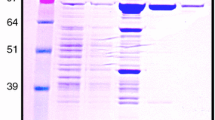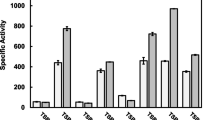Abstract
The work presented in this paper describes the purification and properties of a β-galactosidase from the protozoan Tritrichomonas foetus. An inexpensive and straightforward method for extraction of the enzyme involving ammonium sulphate precipitation, ion exchange and affinity chromatography resulted in a high level of purification. After purification β-N-acetylglucosaminidase was the only enzyme present as a contaminant at a significant level. The β-galactosidase isolated had a pH optimum of 5.8. The Km determined at pH 5.8 was found to be 2.2 mM. Interesting results were obtained when studies were carried out to determine the effect of various metal ions on enzyme activity. Of the metal ions used in this study only manganese ions were found to activate the enzyme. This seems to be a characteristic of trichomonad enzymes, as N-acetyl-β-glucosaminidase, a-galactosidase and N-acetyl-a-galactosaminidase are also activated by manganese ions. The strongest inhibition was recorded with lead and to a lesser extent by zinc. The result with lead is not unexpected as the heavy metal is known to cause irreversible inhibition by binding to the amino-acid backbone of the enzyme. The result with zinc is interesting as high levels of zinc are present and trichomonads are known to be apathogenic in semen. The purified β-galactosidase was found to have the capacity to hydrolyse lactose (Gal β1-4 Glc), lacto-N-biose 1 (Gal β1-3 GlcNAc) and N-acetyllactosamine (Gal β1-4 GlcNAc). When the enzyme was applied to a non-denaturing polyacrylamide gel a single band was observed when stained with Coomassie brilliant blue. This band coincided with that obtained when the gel was stained with p-nitrophenyl β-galactopyranoside. When the same gel was incubated with p-nitrophenyl N-acetyl β-glucopyranoside a band was detected which did not coincide with that of β-galactosidase. Since the β-N-acetylglucosaminidase enzyme does not move to the same position on a non-denaturing gel as the β-galactosidase, we will use this technique to isolate the latter enzyme and determine the N-terminal sequence as a prelude to cloning and further study of the gene.
Similar content being viewed by others
References
Bartlett DE (1949) JAVMA 114: 293-305.
Alstad AD, Fischer K, KroghD (1986) North Dakota Farm Res 43: 16-17.
Goodger WJ, Skirrow SZ (1987) JAVMA 18: 772-76.
Coombs GH, North MJ (1983) Parasitol Today 86: 1-6.
Garber GH, Lemchuk-Favel LT (1989) Canadian J Microbiol 35: 903-9.
Lockwood BC, North MJ (1984) Exp Parasitol 158: 245-53.
Neale KA, Alderete JF (1990) Infect Immun 58: 158-62.
Romanovska E, Watkins WM (1963) Biochem J 87: 37-38.
Harrap GJ, Watkins WM (1970) Biochem J 117: 667-75.
Yates AD, Morgan WTJ, Watkins WM (1975) FEBS ¸ett 62: 281-85.
BonDurant RH, Honigberg BM (1994) In Parasitic Protozoa, Vol. 9, (Kreier JP, ed.) New York: Academic Press.
Watkins WM (1959) Biochem J 71: 261-74.
Bradford M (1976) Anal Biochem 72: 248-54.
Author information
Authors and Affiliations
Rights and permissions
About this article
Cite this article
Vella, M., Greenwell, P. Purification and partial characterization of β-galactosidase from Tritrichomonas foetus . Glycoconj J 14, 883–887 (1997). https://doi.org/10.1023/A:1018506525396
Issue Date:
DOI: https://doi.org/10.1023/A:1018506525396




